Seven Questions Over Breakfast with Rick Allen
 November 11th, 2014 by jules
November 11th, 2014 by jules
 It’s such a pleasure to have printmaker and illustrator Rick Allen visit 7-Imp this morning, especially to read his thoughtful responses to my questions below — and, of course, to see his compelling prints as well.
It’s such a pleasure to have printmaker and illustrator Rick Allen visit 7-Imp this morning, especially to read his thoughtful responses to my questions below — and, of course, to see his compelling prints as well.
Rick is up in cold, windy Minnesota in a city on Lake Superior’s north shore, and as you’ll read below, it’s just the right place for him to be. His first book was self-published via Kenspeckle Letterpress, which he describes as “original letterpress artwork, giclees, notecards, prints and posters…[with] his creative muse: Marian Lansky.” His other two books were published by Houghton Mifflin Harcourt and written by award-winning children’s book author and poet Joyce Sidman. The first, Dark Emperor & Other Poems of The Night, received a 2011 Newbery Honor. And I wrote here at Kirkus about their latest collaboration, Winter Bees & Other Poems of The Cold, released just last week. Allen’s illustrations for each are exquisite.
For our fake cyber-breakfast, which I very much wish were real and in-person, Rick’s going to be brave and go for coffee. “Breakfast,” he told me, “is multiple cups of tea, usually black tea of varying strength, depending upon how long I forget it’s been steeping (credit chris). In the last few years, I’ve been experimenting with drinking coffee in the morning; to make it palatable I generally lash in great quantities of half-and-half, so perhaps it’s coffee-tinted cream that I’m drinking. We had a Swedish great-grandmother, who used to slurp coffee from a saucer into my siblings and me when we were just months old, and it may have taken a half-century to overcome that early cultural conditioning to try coffee, or near-coffee, again.”
I can always help people find their way to coffee!
I thank him for visiting.
Rick: Illustrator — and definitely not author slash illustrator. I tend to be wordy but haven’t ever tried to push those words around into anything like a narrative, beyond the title for a print. And since book illustration itself hasn’t been a primary focus for me, I should probably say I’m a printmaker/illustrator, just for accuracy’s sake.



Rick:
- The First Chinook: The Adventures of Arthur T. Walden and His Legendary Sled Dog, Chinook by David Pagel (The Kenspeckle Letterpress, 2005)
- Dark Emperor & Other Poems of The Night by Joyce Sidman (Houghton Mifflin Harcourt, 2010)
- Winter Bees & Other Poems of The Cold by Joyce Sidman (Houghton Mifflin Harcourt, November 2014)
(Click image to read the poem and see the spread in its entirety)
(Click image to read the poem and see the spread in its entirety)
(Click image to read the poem and see the spread in its entirety)
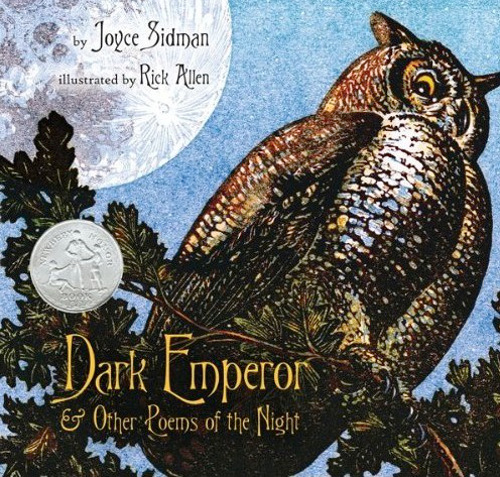
Jules: What is your usual medium?
Rick: I most often work in wood engraving and linoleum block prints, both traditional relief print media, with some drawing and painting (usually in gouache) wrapped up into that process. Relief printing involves cutting away material from the block until only the image remains to take ink and print the image, and it’s cut in reverse to make the image print right. The farther you get into the cutting and the more time you’ve got invested into the block, the less room you have to make a mistake and the more probable it is you’re going to make that mistake. It’s like playing a game of graphic Jenga: How much can you remove before you cause the whole thing to collapse? And until you pull a proof of the image, you can’t be entirely sure you haven’t made a slip of the hand that is either a fatal mistake or an inspired accident that makes the picture. I’ve frequently had to start the whole thing over and begin a new block because of a cut too far. It’s exciting, in the way watching two snails race can be exciting — you’ve got to have a long attention span and an appreciation for the small detail.
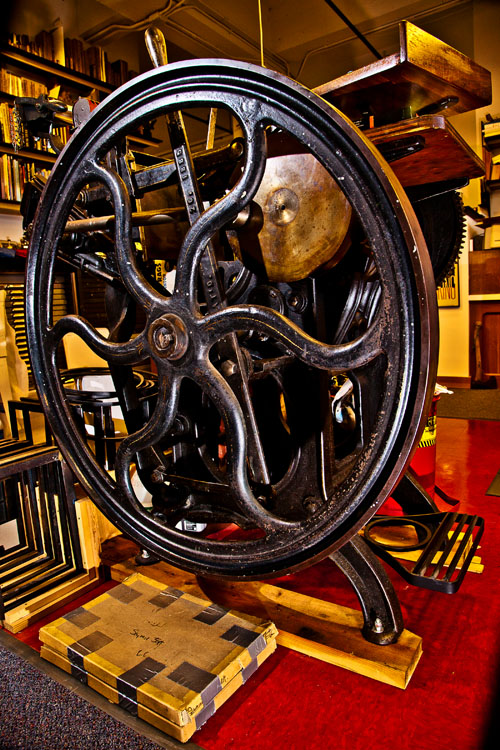

as we print blocks.”

Rick: Duluth, Minnesota. Where the winds hit heavy on the borderline.

Rick: We self-published The First Chinook, a Robert W. Service-like epic poem featuring a true-life sled dog story from the 1920s. (We’re still astonished that Disney hasn’t ever found and wagged this amazing tale.) It was written by a friend whose journalistic day job was writing and editing for climbing and mountaineering magazines. I did almost forty wood engravings in six months and developed a nearly permanent squint. My wife, Marian, digitally colored the engravings and designed the book. In this adventure, we learned that book publishing is a noble undertaking and that we didn’t want to do it again.
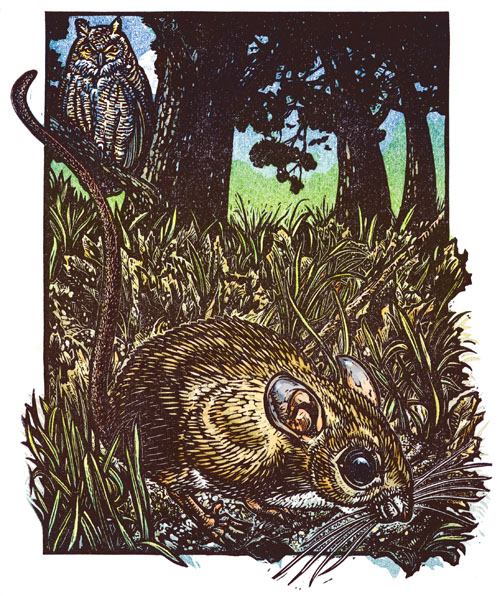
printed from three blocks and hand-colored

in our shop. This is a sheet of random pen and ink doodles,
exploring the possibilities of owl personalities.”
For Dark Emperor, I was contacted by Ann Rider, Joyce Sidman’s incredible editor at Houghton Mifflin Harcourt, who lives just a little bit farther up Lake Superior’s north shore and had become aware of my work through a local gallery.
With Winter Bees, both Ann and Joyce were willing to take me along on the ride again.
Jules: Can you please point readers to your web site and/or blog?
Rick: www.kenspeckleletterpress.com/ and
www.kenspeckleletterpress.com/blogspeckle/.
(Click to enlarge)
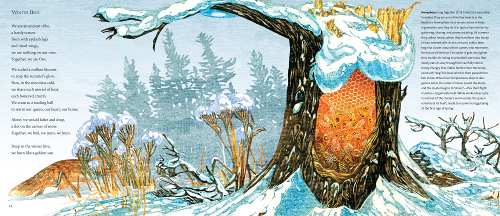
(Click to enlarge)

(Click to enlarge)
(Houghton Mifflin, November 2014)
Rick: No new titles in hand for the now, so I’m working on drawings, paintings, and prints for the annual gallery show we do in April. Which in Duluth truly can be the cruelest month, with measurable snowfall still being more likely than green grass and with lilacs that won’t bloom in the dooryard for another two months.
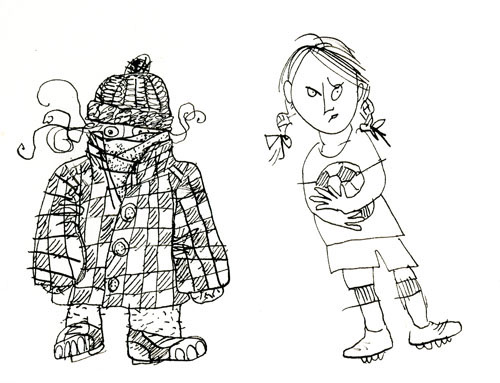

We might have a name for the raccoon, but no story.”
 Okay, we’ve got more coffee, and it’s time to get a bit more detailed with seven questions over breakfast. I thank Rick again for visiting 7-Imp.
Okay, we’ve got more coffee, and it’s time to get a bit more detailed with seven questions over breakfast. I thank Rick again for visiting 7-Imp.
1. Jules: What exactly is your process when you are illustrating a book? You can start wherever you’d like when answering: getting initial ideas, starting to illustrate, or even what it’s like under deadline, etc. Do you outline a great deal of the book before you illustrate or just let your muse lead you on and see where you end up?
Rick: Definitely that thing with the muse and seeing where we all end up. But I’ve only worked on three books (and, oddly enough, they’ve all been poetry) and each book has been done differently, so it’s hard to say that I’ve got a process in place.
The first book was done in wood engravings, the second (Dark Emperoror) consisted of 12 multiple-block linoleum prints finished with hand coloring, and the last (Winter Bees) was made from nearly 200 individual blocks that were printed, hand-colored, and then scanned and digitally composed for the final spread. Most of my time early on is spent reading and re-reading the poems and trying to track the visuals which occur to me as I go, like walking through the woods and noticing the small half-heard or almost-glimpsed animals as you pass through.

I recall poetry being defined as something that explains nothing but makes everything understandable, and I think of images accompanying the poetry as being similar: There has to be enough room left in an image for the viewer to bring their own imagination to it — and take away their own meaning from it. I’ll do some very rough sketches, rough enough so that they’re entirely cryptic to anyone else without a paragraph of explanation accompanying them. Those rough sketches leave me ample sea room to continue changing and refining the image as I get the drawing onto the block and then begin cutting the block for printing.

from sketch to initial color separation trials of two registered blocks.”

in ‘Under Ice’ [in Winter Bees]” …
As I mentioned earlier, printmaking by its nature can be an extremely controlled and controlling medium, but since I’m largely self-taught as a printmaker, I’ve contrived my own left-handed ways of going about it that encourage a degree of improvisation throughout. For example, if the drawing on the block is too tightly finished, you’re apt to just reproduce its lines in the cutting, which may take a little life out of the final print. So I keep the drawing on the block loose enough to serve only as a suggested starting place and to cut the image as freely as I can, departing from the drawing as seems advisable or necessary as it goes along. This process also requires an extremely patient and tolerant editor, who can accommodate a deal of uncertainty, which I’ve been incredibly fortunate to have in Ann Rider at Houghton.

on our little Vandercook proof press #1 …”
Rick: I currently work with my wife and creative partner, Marian, in a warren of three randomly connected offices in an old factory building in Duluth, about a block from Lake Superior; in one form or another we’ve been in the building since 1989. The largest room houses our four presses (the oldest dating back to 1897 and the youngest to the mid-1950s) and cabinets of wood and metal type, flat files of paper, paper cutter, ink, and all the outdated odds and ends that we use in the lino blocks, wood engravings, and typeset projects we produce.
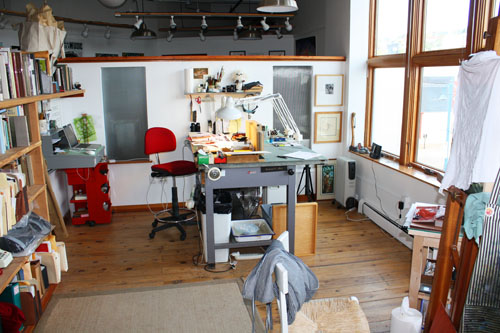
Marian has her own office where she spends time in the 21st-century work (she was an early adopter of Mac computers in her graphic design business back in ‘89) with an array of computers and their attendant scanners and giclee printers. I’m located in still another studio/gallery space with an old drafting desk, bookshelves, and an easel; we open the gallery space in a random sort of way to show and sell our work when we can. All the rooms have huge north-facing windows that make for a fantastic working light. We couldn’t be more fortunate in our workplace; this building is its own village, with shops and offices and people we’ve come to know over more than 25 years of residence, right on the shore of the greatest of the Great Lakes.

Rick: How early is early? I think reading became important to me first in high school under the influence of several memorable English and history teachers, who got the canon of classic Western lit drilled into our bones. Melville, Dickinson, Whitman, and Twain. Shakespeare, Tennyson, Yeats, and Dylan Thomas. Frost and Lincoln.
And illustrators? There are far too many: Winslow Homer, Arthur Rackham, Elizabeth Shippen Green, Beatrix Potter, Howard Pyle and N. C. Wyeth, Rockwell Kent, Lynd Ward, Robert Lawson, Wanda Gág (there’s an accent in there I can’t manufacture), the d’Aulaires, Gorey, Sendak. …

not adjusted for inflation.”
We had a Carnegie Library here in Duluth as I grew up, with a large, comprehensive children’s room that I escaped as soon as I was old enough to head up the stairs to the large copper-domed adult reference room and the thick translucent glass floors in the stacks that allowed spectrally-diffused feet to appear above you and shadows that passed quietly beneath your own feet as you browsed through books that had been on the shelves since Moses, or at least since Andrew Carnegie put them there. It was a place that gave books a living presence for me — and where I first had the sense that you could use books to help create your own interior life.


4. Jules: If you could have three (living) authors or illustrators—whom you have not yet met—over for coffee or a glass of rich, red wine, whom would you choose? (Some people cheat and list deceased authors/illustrators. I won’t tell.)
Rick: While I’d really like to see (and talk to) dead people, at least some of those listed above, among the living I wouldn’t mind having a pint with Christopher Wormell, Michael Sowa, or Tomi Ungerer.

A work literally in progress….”

taped together in preparation for transfer to the first block …”

and The Long View. Some of the inks….”
5. Jules: What is currently in rotation on your iPod or loaded in your CD player? Do you listen to music while you create books?
Rick: For most of my life, I listened constantly to the radio while I worked: pop, classical, or talk. (Once, pulling an all-nighter on a project, I listened to the BBC World Service interview a farmer in the English Midlands, who collected potatoes that resembled famous people, which has left me with an almost hallucinogenic-seeming memory.) The last few years I’ve gone through a period of not listening to anything while working, and I’m just now starting to have an iPod, shuffling music at my desk. The shuffle function may be the most wonderful technological advance in my cast-iron shop: the resulting playlists are often startling and, occasionally, gobstopperingly magical. Today’s shuffle started with bagpipes and then moved on to Finnish accordionist Maria Kalaniemi; June Tabor, singing “Body And Soul”; a local blues guitarist, named Charlie Parr; Mary Gauthier from New Orleans; and a Swedish fiddle trio called Väsen. This was followed by Handel, Ella Fitzgerald, Hot Tuna, Bach, The Pogues, Keith Jarrett, Bonnie Raitt, Dire Straits, The Roches, Leonard Cohen, Jim Hall, and Tom Waits. And, always, there’s the uneasy memory of a British tuber that may have resembled Margaret (or was it Dennis?) Thatcher lingering in the background of my ear’s mind.


Very squinty work.”
Rick: I didn’t learn to tie my shoes until first grade. But I did learn it well enough then to retain the skill up to now.
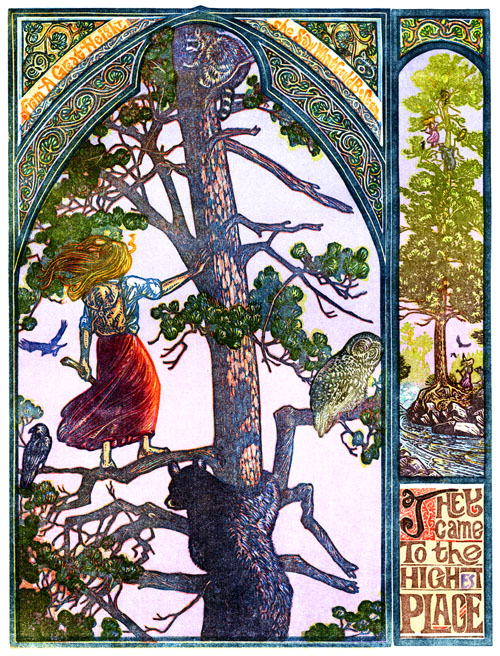
Twenty-six blocks, no hand-coloring. It almost beat us.”
Rick: I haven’t been interviewed enough to know. I’m still surprised by the questions that are asked.

— from 12 blocks with some hand-coloring.”

Rick: That’s like being asked to choose a favorite child. I love ‘em all, each in their own way. Although “hystricine” is very nice. And “phillumeny.” Or “flosculation.” …
Jules: What is your least favorite word?
Rick: “Should,” as in what you should do, or should be, or should have done. …
Jules: What turns you on creatively, spiritually or emotionally?
Rick: Damp, drizzly November-in-your-soul weather, like a nor’easter with great waves and horizontal rain/sleet/snow driving in off the lake. Wonderful, as long as you’re on shore. And words. Music. Printing shops. Surprising and random idle associations of unconnected ideas. My wife, always.
Jules: What turns you off?
Rick: Emotional conflict of nearly any kind. Hot humid weather; I’m primarily a psychrophilic animal, which made Winter Bees a good fit for me. Nothing like spending a couple of years in winter on a book.
Jules: What is your favorite curse word? (optional)
Rick: Entirely situational.
Jules: What sound or noise do you love?
Rick: Any kind of boat moving through water. A brayer rolling up ink — and a platen letterpress in operation.
Jules: What sound or noise do you hate?
Rick: A boat’s keel hitting ledge rock, or a case of six-point metal type falling to the floor — the unpleasant knell of an incipient disaster in either instance.
Jules: What profession other than your own would you like to attempt?
Rick: I’ve taken a long and indirect path to reach a point where I’m doing pretty much just what I want to do and can make a living by doing just that; it’s so rare a condition for someone working at their art that I don’t for a moment wish there were anything else I could be doing. Before getting here, I had years and years of varied and odd jobs: I was a canoe guide in the very-nearly-far north and a partner in an ice-climbing school in the even-slightly-further north. I worked retail in an outdoor gear store and in a tiny neighborhood bookstore, specializing in children’s books (back when neighborhood bookstores weren’t all that rare), which was conveniently located next to a bakery that made chocolate croissants fresh every morning. While living in Germany I had a part-time job as a kindermaedchen—a nanny—for three kids aged two, three, and five. And like many failed humanists with a degree in History (in my case, in the relationship between art and science during the Italian Renaissance, which predictably proved to have little traction in the real world of gainful employment), I worked as a paralegal for a large law firm, as I pondered a possible future as an attorney. And I delivered a large wooden sloop from the far western end of Lake Superior to New York City via the Great Lakes and the Erie Canal without once sinking it in 1,500 miles. Now I stay in the print shop to pet the presses and to be mindful of my immense good luck in being able to do what I most want to do, for as long as I can do it.
Jules: What profession would you not like to do?
Rick: Anything, absolutely anything, requiring numeracy.
Jules: If Heaven exists, what would you like to hear God say when you arrive at the Pearly Gates?
Rick: “You certainly took your time getting here.”
All photos are used with permission of Rick Allen.
WINTER BEES & OTHER POEMS OF THE COLD. Text copyright © 2014 by Joyce Sidman. Illustrations copyright © 2014 by Rick Allen. Illustrations reproduced by permission of the publisher, Houghton Mifflin Harcourt, Boston.
DARK EMPEROR & OTHER POEMS OF THE NIGHT. Text copyright © 2010 by Joyce Sidman. Illustrations copyright © 2010 by Rick Allen. Illustrations reproduced by permission of the publisher, Houghton Mifflin Harcourt, Boston.
The spiffy and slightly sinister gentleman introducing the Pivot Questionnaire is Alfred, copyright © 2009 Matt Phelan.





Wonderful interview and article!
I am going to send it ’round to some fans in the family!
What a nice way to start my morning, coffee and this lovely interview. Thank you!
with the wind heavy on the borderline, and wood ablaze in the stove, this interview was the perfect excuse to remain indoors an extra ten minutes. Nice to get to know you a bit better, Ricardo.
Thank you so much for this, Jules and Rick! I’ve had this book on my library hold list, waiting for it to come in, for a couple of months now! Being a Minnesotan with Duluth roots and a love for the North Shore…this interview made me sooo happy 🙂
I really enjoyed the interview. It was wonderful to see the background process for the prints that we have thoroughly enjoyed. It is always a chuckle to be exposed to Rick’s humor.
It was great to read more about Rick’s and Marian’s rich experiences that led them to the present.
Bravo all around! Duluth is the luckiest because Kenspeckle calls it home.
This interview is such a delight to read and a visual feast. I particularly enjoy the the tidbit “with her concertina, the trapper’s daughter would sing to the pickerel.” How wonderful!
Can’t wait to see the bee book. What GORGEous images.
Ooooo la la.
Congratulations on the great article and new publication.
Thanks for the heart-warming interview. I feel very lucky that I’ve met Rick, Marian and Janelle at their studio/shop during a short visit to Duluth last winter.
Prints are my favorite medium, and this is as good as a full semester’s course in how it’s done! Thank you, Jules, and wow, Rick!
So beautiful! Yay for line and color!
Thank you, Jules. You really captured the man. I love this interview!
[…] Check out this blog post about Rick Allen’s artistic process: http://blaine.org/sevenimpossiblethings/?p=3572 […]
[…] Seven Questions Over Breakfast with Rick Allen (Illustrator / Printmaker) http://blaine.org/sevenimpossiblethings/?p=3572 Rick Allen: Kenspeckleletter Press https://www.kenspeckleletterpress.com National Geographic […]